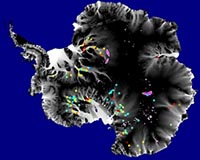| . |  |
. |
London UK (SPX) Feb 25, 2011 Tiny Antarctic marine creatures collected 100 years ago by Antarctic explorer Captain Robert Falcon Scott give new clues about polar environmental change. By comparing present-day bryozoans - a sea-bed filter-feeding animal that looks like branching twigs - with specimens from Scott's expeditions scientists have found the first conclusive evidence of increased carbon uptake and storage by Antarctic marine life. Reporting this week in the journal Current Biology an international team of scientists explain how they examined annual growth bands in skeletons of specimens of bryozoans (Cellarinella nutti) collected from Antarctica's Ross Sea during the Census of Antarctic Marine Life. When compared with museum collections in the UK, US and New Zealand - including specimens from Scott's expeditions - they found that since 1990 bryozoans grew more rapidly than at any time before. The most likely explanation is greater availability of food (phytoplankton). The findings suggest that this new growth is an important mechanism for transferring carbon into the sea bed. Lead author, Dr Dave Barnes, of the British Antarctic Survey (BAS) says, "For the first time we've been able to use the longest record of animal growth as evidence of rapid recent change to life on the seabed. Scott's biological collections are considerable in quality and quantity and will continue to become even more valuable for determining how life responds to change across time. Few biological studies in Antarctica go back more than 30 years, so these data are invaluable and highlight the importance of long-term monitoring." The spurt in growth means that animals reach the size earlier at which ocean currents snap them off. As the animals topple over they bury carbon, therefore increasing the seabed's potential as a carbon sink.
Share This Article With Planet Earth
Related Links British Antarctic Survey Beyond the Ice Age
 Carbon Sink At South Pole Has Grown Recently
Carbon Sink At South Pole Has Grown RecentlyLondon UK (SPX) Feb 23, 2011 By studying collections of a marine bryozoan that date back to a famous 1901 expedition to the South Pole, researchers have found that those organisms were growing steadily up until 1990, when their growth more than doubled. The data, reported in the February 22 issue of Current Biology, a Cell Press publication, provide the highest-latitude record of a century of growth and some of the first ev ... read more |
|
| The content herein, unless otherwise known to be public domain, are Copyright 1995-2010 - SpaceDaily. AFP and UPI Wire Stories are copyright Agence France-Presse and United Press International. ESA Portal Reports are copyright European Space Agency. All NASA sourced material is public domain. Additional copyrights may apply in whole or part to other bona fide parties. Advertising does not imply endorsement,agreement or approval of any opinions, statements or information provided by SpaceDaily on any Web page published or hosted by SpaceDaily. Privacy Statement |